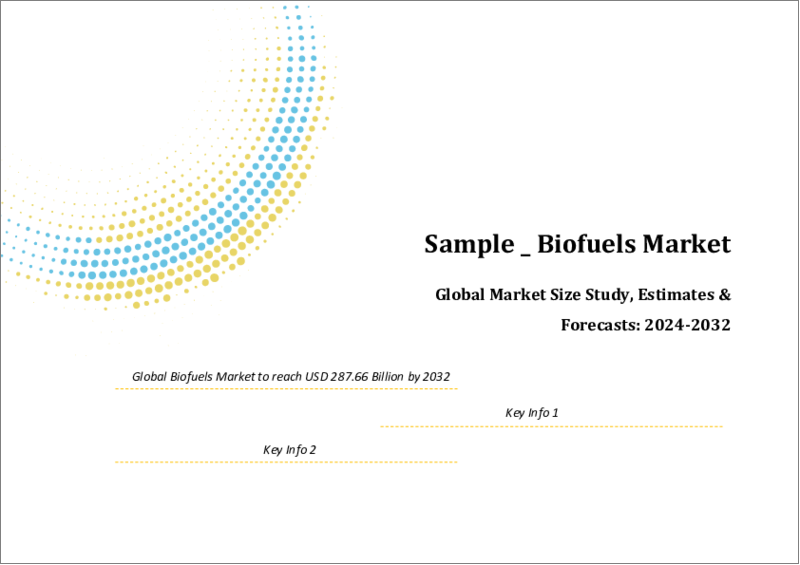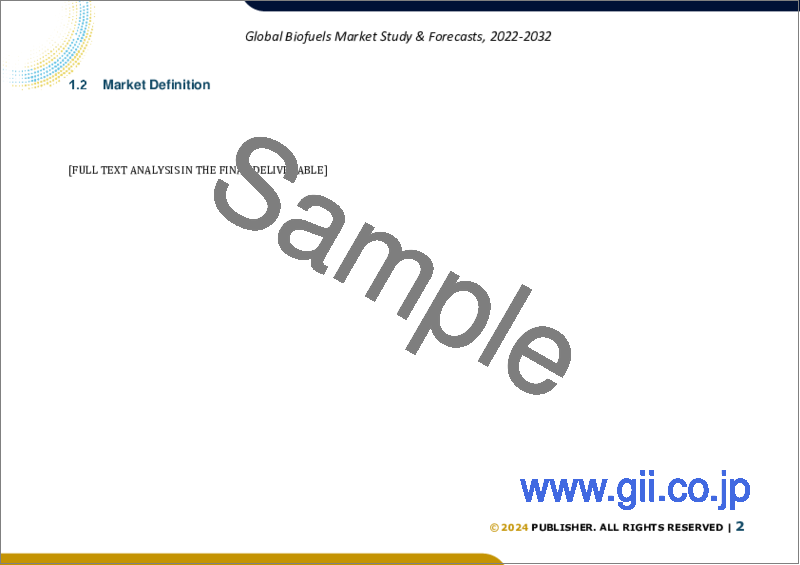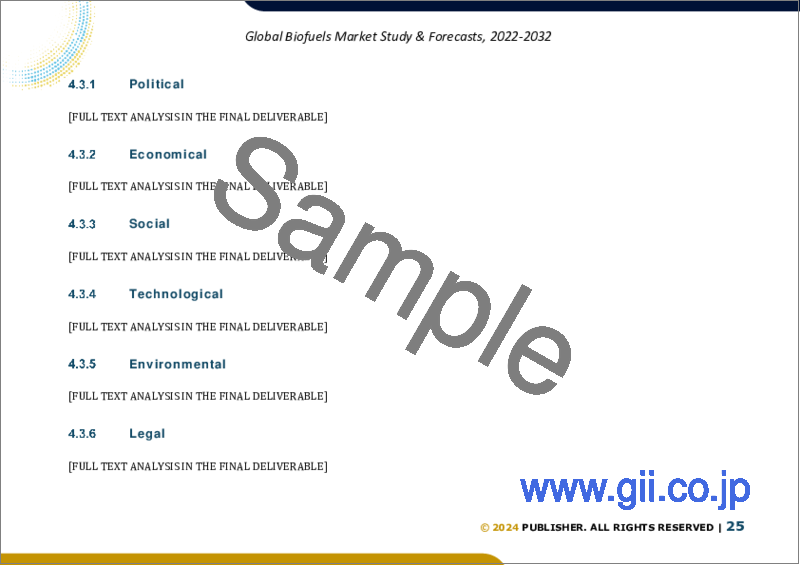|
|
市場調査レポート
商品コード
1507738
バイオ燃料の世界市場規模調査:燃料タイプ別、原料別、地域別予測 2022-2032年Global Biofuels Market Size study, by Fuel Type (Ethanol, Biodiesel, Other Fuel Types) by Feedstock (Palm Oil, Jatropha, Sugar Crop, Coarse Grain, Other Feedstock) and Regional Forecasts 2022-2032 |
||||||
カスタマイズ可能
|
|||||||
| バイオ燃料の世界市場規模調査:燃料タイプ別、原料別、地域別予測 2022-2032年 |
|
出版日: 2024年07月03日
発行: Bizwit Research & Consulting LLP
ページ情報: 英文 200 Pages
納期: 2~3営業日
|
全表示
- 概要
- 図表
- 目次
世界のバイオ燃料市場は、2023年に約1,674億米ドルと評価され、予測期間2024-2032年には6.20%以上の健全な成長率で成長すると予測されています。
バイオ燃料は、植物、藻類、廃棄物バイオマスなどの有機物から得られる再生可能な燃料です。バイオ燃料は、ガソリンやディーゼルといった従来の化石燃料の代替燃料と考えられており、温室効果ガスの排出削減や、有限な化石燃料資源への依存度の低下といった潜在的なメリットをもたらします。バイオ燃料は主に3種類に分類される:第一世代バイオ燃料、第二世代バイオ燃料、第三世代バイオ燃料です。また、農業残渣、藻類、エネルギー専用作物などの非食糧バイオマス資源から生産される第二世代および第三世代バイオ燃料の開発にも注目が集まっています。これらの先進バイオ燃料は、持続可能性が向上し、食用作物との競合が減少します。
さらに、原油価格の変動はバイオ燃料のコスト競争力に影響を与えます。原油価格が高騰すると、バイオ燃料の経済性が高まり、再生可能な代替燃料への需要が高まる。また、都市化と人口増加に伴い、輸送用燃料の需要も増加しています。バイオ燃料は、従来のガソリンやディーゼルに代わる持続可能な代替燃料であり、特に輸送部門では、既存のインフラに最小限の改良を加えるだけで使用できます。さらに、研究開発の継続的な取り組みとバイオ燃料生産インフラへの投資が技術革新を促進し、市場におけるバイオ燃料の利用可能性を拡大しています。しかし、高額な初期設備投資が必要であること、世界的に経済状況が不透明であることが、予測期間2024-2032年の市場成長の妨げになると予想されます。
バイオ燃料の世界市場調査において考慮した主な地域は、アジア太平洋地域、北米、欧州、中南米、その他欧州地域です。北米は、豊富な原料供給、バイオ燃料生産のための強固なインフラ、バイオ燃料消費を促進する有利な政府規制により、2023年のバイオ燃料市場を独占しました。これらの要因により、同地域は世界のバイオ燃料市場をリードしています。さらに、バイオ燃料の研究開発への投資の増加や、バイオ燃料プロジェクトに対する政府の助成金や補助金が、バイオ燃料産業の革新と拡大を促進しています。こうした財政支援は、生産能力を拡大し、バイオ燃料技術の実行可能性を向上させるのに役立っています。さらに、アジア太平洋地域は2024年から2032年の予測期間中に最も速い速度で成長すると予想されています。
目次
第1章 世界のバイオ燃料市場の定義と調査前提条件
- 調査目的
- 市場の定義
- 調査前提条件
- 包含と除外
- 制限事項
- 供給サイドの分析
- 入手可能性
- インフラ
- 規制環境
- 市場競争
- 経済性(消費者の視点)
- 需要サイド分析
- 規制の枠組み
- 技術の進歩
- 環境への配慮
- 消費者の意識と受容
- 調査手法
- 調査対象年
- 通貨換算レート
第2章 エグゼクティブサマリー
- バイオ燃料の世界市場規模・予測(2022年~2032年)
- 地域別概要
- セグメント別概要
- 燃料タイプ別
- 原料別
- 主要動向
- 景気後退の影響
- アナリストの結論・提言
第3章 世界のバイオ燃料市場力学
- 市場促進要因
- 市場の課題
- 市場機会
第4章 世界のバイオ燃料市場産業分析
- ポーターのファイブフォースモデル
- 供給企業の交渉力
- 買い手の交渉力
- 新規参入業者の脅威
- 代替品の脅威
- 競争企業間の敵対関係
- ポーターのファイブフォースモデルへの未来的アプローチ
- ポーターのファイブフォースの影響分析
- PESTEL分析
- 政治
- 経済
- 社会
- 技術
- 環境
- 法律
- 主な投資機会
- 主要成功戦略
- 破壊的動向
- 業界専門家の視点
- アナリストの結論・提言
第5章 バイオ燃料の世界市場規模・予測:燃料タイプ別 2022-2032年
- エタノール
- バイオディーゼル
- その他の燃料タイプ
第6章 バイオ燃料の世界市場規模・予測:原料別 2022-2032年
- パーム油
- ジャトロファ
- 砂糖作物
- 粗粒穀物
- その他の原料
第7章 バイオ燃料の世界市場規模・予測:地域別 2022-2032年
- 北米のバイオ燃料市場
- 米国
- 燃料タイプ別、市場規模&予測、2022-2032年
- 原料別、市場規模&予測、2022-2032年
- カナダのバイオ燃料市場
- 米国
- 欧州のバイオ燃料市場
- 英国のバイオ燃料市場
- ドイツのバイオ燃料市場
- フランスのバイオ燃料市場
- スペインのバイオ燃料市場
- イタリアのバイオ燃料市場
- その他欧州のバイオ燃料市場
- アジア太平洋のバイオ燃料市場
- 中国のバイオ燃料市場
- インドのバイオ燃料市場
- 日本のバイオ燃料市場
- オーストラリアのバイオ燃料市場
- 韓国のバイオ燃料市場
- その他アジア太平洋地域のバイオ燃料市場
- ラテンアメリカのバイオ燃料市場
- ブラジルのバイオ燃料市場
- メキシコのバイオ燃料市場
- その他ラテンアメリカのバイオ燃料市場
- 中東・アフリカのバイオ燃料市場
- サウジアラビアのバイオ燃料市場
- 南アフリカのバイオ燃料市場
- その他中東とアフリカのバイオ燃料市場
第8章 競合情報
- 主要企業のSWOT分析
- 主要市場戦略
- 企業プロファイル
- Air Liquide
- 主要情報
- 概要
- 財務(データの入手可能性によります)
- 製品概要
- 市場戦略
- Archer Daniels Midland Company
- Bunge North America, Inc.
- Butamax Advanced Biofuels LLC
- Green Plains Inc.
- Petroleo Brasileiro S.A.
- Renewable Energy Group, Inc.
- Royal Dutch Shell plc
- Scandinavian Biogas Fuels International AB
- Wilmar International Limited
- Air Liquide
第9章 調査プロセス
- 調査プロセス
- データマイニング
- 分析
- 市場推定
- 検証
- 出版
- 調査属性
LIST OF TABLES
- TABLE 1. Global Biofuels market, report scope
- TABLE 2. Global Biofuels market estimates & forecasts by Region 2022-2032 (USD Billion)
- TABLE 3. Global Biofuels market estimates & forecasts by Fuel Type 2022-2032 (USD Billion)
- TABLE 4. Global Biofuels market estimates & forecasts by Feedstock 2022-2032 (USD Billion)
- TABLE 5. Global Biofuels market by segment, estimates & forecasts, 2022-2032 (USD Billion)
- TABLE 6. Global Biofuels market by region, estimates & forecasts, 2022-2032 (USD Billion)
- TABLE 7. Global Biofuels market by segment, estimates & forecasts, 2022-2032 (USD Billion)
- TABLE 8. Global Biofuels market by region, estimates & forecasts, 2022-2032 (USD Billion)
- TABLE 9. Global Biofuels market by segment, estimates & forecasts, 2022-2032 (USD Billion)
- TABLE 10. Global Biofuels market by region, estimates & forecasts, 2022-2032 (USD Billion)
- TABLE 11. Global Biofuels market by segment, estimates & forecasts, 2022-2032 (USD Billion)
- TABLE 12. Global Biofuels market by region, estimates & forecasts, 2022-2032 (USD Billion)
- TABLE 13. Global Biofuels market by segment, estimates & forecasts, 2022-2032 (USD Billion)
- TABLE 14. Global Biofuels market by region, estimates & forecasts, 2022-2032 (USD Billion)
- TABLE 15. U.S. Biofuels market estimates & forecasts, 2022-2032 (USD Billion)
- TABLE 16. U.S. Biofuels market estimates & forecasts by segment 2022-2032 (USD Billion)
- TABLE 17. U.S. Biofuels market estimates & forecasts by segment 2022-2032 (USD Billion)
- TABLE 18. Canada Biofuels market estimates & forecasts, 2022-2032 (USD Billion)
- TABLE 19. Canada Biofuels market estimates & forecasts by segment 2022-2032 (USD Billion)
- TABLE 20. Canada Biofuels market estimates & forecasts by segment 2022-2032 (USD Billion)
- TABLE 21. UK Biofuels market estimates & forecasts, 2022-2032 (USD Billion)
- TABLE 22. UK Biofuels market estimates & forecasts by segment 2022-2032 (USD Billion)
- TABLE 23. UK Biofuels market estimates & forecasts by segment 2022-2032 (USD Billion)
- TABLE 24. Germany Biofuels market estimates & forecasts, 2022-2032 (USD Billion)
- TABLE 25. Germany Biofuels market estimates & forecasts by segment 2022-2032 (USD Billion)
- TABLE 26. Germany Biofuels market estimates & forecasts by segment 2022-2032 (USD Billion)
- TABLE 27. France Biofuels market estimates & forecasts, 2022-2032 (USD Billion)
- TABLE 28. France Biofuels market estimates & forecasts by segment 2022-2032 (USD Billion)
- TABLE 29. France Biofuels market estimates & forecasts by segment 2022-2032 (USD Billion)
- TABLE 30. Italy Biofuels market estimates & forecasts, 2022-2032 (USD Billion)
- TABLE 31. Italy Biofuels market estimates & forecasts by segment 2022-2032 (USD Billion)
- TABLE 32. Italy Biofuels market estimates & forecasts by segment 2022-2032 (USD Billion)
- TABLE 33. Spain Biofuels market estimates & forecasts, 2022-2032 (USD Billion)
- TABLE 34. Spain Biofuels market estimates & forecasts by segment 2022-2032 (USD Billion)
- TABLE 35. Spain Biofuels market estimates & forecasts by segment 2022-2032 (USD Billion)
- TABLE 36. RoE Biofuels market estimates & forecasts, 2022-2032 (USD Billion)
- TABLE 37. RoE Biofuels market estimates & forecasts by segment 2022-2032 (USD Billion)
- TABLE 38. RoE Biofuels market estimates & forecasts by segment 2022-2032 (USD Billion)
- TABLE 39. China Biofuels market estimates & forecasts, 2022-2032 (USD Billion)
- TABLE 40. China Biofuels market estimates & forecasts by segment 2022-2032 (USD Billion)
- TABLE 41. China Biofuels market estimates & forecasts by segment 2022-2032 (USD Billion)
- TABLE 42. India Biofuels market estimates & forecasts, 2022-2032 (USD Billion)
- TABLE 43. India Biofuels market estimates & forecasts by segment 2022-2032 (USD Billion)
- TABLE 44. India Biofuels market estimates & forecasts by segment 2022-2032 (USD Billion)
- TABLE 45. Japan Biofuels market estimates & forecasts, 2022-2032 (USD Billion)
- TABLE 46. Japan Biofuels market estimates & forecasts by segment 2022-2032 (USD Billion)
- TABLE 47. Japan Biofuels market estimates & forecasts by segment 2022-2032 (USD Billion)
- TABLE 48. Australia Biofuels market estimates & forecasts, 2022-2032 (USD Billion)
- TABLE 49. Australia Biofuels market estimates & forecasts by segment 2022-2032 (USD Billion)
- TABLE 50. Australia Biofuels market estimates & forecasts by segment 2022-2032 (USD Billion)
- TABLE 51. South Korea Biofuels market estimates & forecasts, 2022-2032 (USD Billion)
- TABLE 52. South Korea Biofuels market estimates & forecasts by segment 2022-2032 (USD Billion)
- TABLE 53. South Korea Biofuels market estimates & forecasts by segment 2022-2032 (USD Billion)
- TABLE 54.
- TABLE 55. RoAPAC Biofuels market estimates & forecasts, 2022-2032 (USD Billion)
- TABLE 56. RoAPAC Biofuels market estimates & forecasts by segment 2022-2032 (USD Billion)
- TABLE 57. RoAPAC Biofuels market estimates & forecasts by segment 2022-2032 (USD Billion)
- TABLE 58. Brazil Biofuels market estimates & forecasts, 2022-2032 (USD Billion)
- TABLE 59. Brazil Biofuels market estimates & forecasts by segment 2022-2032 (USD Billion)
- TABLE 60. Brazil Biofuels market estimates & forecasts by segment 2022-2032 (USD Billion)
- TABLE 61. Mexico Biofuels market estimates & forecasts, 2022-2032 (USD Billion)
- TABLE 62. Mexico Biofuels market estimates & forecasts by segment 2022-2032 (USD Billion)
- TABLE 63. Mexico Biofuels market estimates & forecasts by segment 2022-2032 (USD Billion)
- TABLE 64. RoLA Biofuels market estimates & forecasts, 2022-2032 (USD Billion)
- TABLE 65. RoLA Biofuels market estimates & forecasts by segment 2022-2032 (USD Billion)
- TABLE 66. RoLA Biofuels market estimates & forecasts by segment 2022-2032 (USD Billion)
- TABLE 67. Saudi Arabia Biofuels market estimates & forecasts, 2022-2032 (USD Billion)
- TABLE 68. Saudi Arabia Biofuels market estimates & forecasts, 2022-2032 (USD Billion)
- TABLE 69. Saudi Arabia Biofuels market estimates & forecasts, 2022-2032 (USD Billion)
- TABLE 70. South Africa Biofuels market estimates & forecasts by segment 2022-2032 (USD Billion)
- TABLE 71.
- TABLE 72. South Africa Biofuels market estimates & forecasts by segment 2022-2032 (USD Billion)
- TABLE 73. South Africa Biofuels market estimates & forecasts by segment 2022-2032 (USD Billion)
- TABLE 74. RoMEA Biofuels market estimates & forecasts by segment 2022-2032 (USD Billion)
- TABLE 75. RoMEA Biofuels market estimates & forecasts by segment 2022-2032 (USD Billion)
- TABLE 76. RoMEA Biofuels market estimates & forecasts by segment 2022-2032 (USD Billion)
- TABLE 77. List of secondary sources, used in the study of Global Biofuels Market.
- TABLE 78. List of primary sources, used in the study of Global Biofuels Market.
- TABLE 79. Years considered for the study.
- TABLE 80. Exchange rates considered.
LIST OF FIGURES
- FIG 1. Global Biofuels market, research methodology
- FIG 2. Global Biofuels market, market estimation techniques
- FIG 3. Global market size estimates & forecast methods.
- FIG 4. Global Biofuels market, key trends 2023
- FIG 5. Global Biofuels market, growth prospects 2022-2032
- FIG 6. Global Biofuels market, porters 5 force model
- FIG 7. Global Biofuels market, pestel analysis
- FIG 8. Global Biofuels market, value chain analysis
- FIG 9. Global Biofuels market by segment, 2022 & 2032 (USD Billion)
- FIG 10. Global Biofuels market by segment, 2022 & 2032 (USD Billion)
- FIG 11. Global Biofuels market by segment, 2022 & 2032 (USD Billion)
- FIG 12. Global Biofuels market by segment, 2022 & 2032 (USD Billion)
- FIG 13. Global Biofuels market by segment, 2022 & 2032 (USD Billion)
- FIG 14. Global Biofuels market, regional snapshot 2022 & 2032
- FIG 15. North America Biofuels market 2022 & 2032 (USD Billion)
- FIG 16. Europe Biofuels market 2022 & 2032 (USD Billion)
- FIG 17. Asia pacific Biofuels market 2022 & 2032 (USD Billion)
- FIG 18. Latin America Biofuels market 2022 & 2032 (USD Billion)
- FIG 19. Middle East & Africa Biofuels market 2022 & 2032 (USD Billion)
- FIG 20. Global Biofuels market, company market share analysis (2023)
Global Biofuels Market is valued approximately USD 167.4 billion in 2023 and is anticipated to grow with a healthy growth rate of more than 6.20% over the forecast period 2024-2032. Biofuels are renewable fuels derived from organic materials such as plants, algae, or waste biomass. They are considered an alternative to conventional fossil fuels like gasoline and diesel, offering potential benefits such as reduced greenhouse gas emissions and decreased dependence on finite fossil fuel resources. Biofuels can be categorized into three main types: First-generation biofuels, Second-generation biofuels, and Third-generation biofuels. Also, there was a growing focus on advancing second-generation and third-generation biofuels, which are produced from non-food biomass sources such as agricultural residues, algae, and dedicated energy crops. These advanced biofuels offer improved sustainability and reduced competition with food crops.
Moreover, the fluctuations in crude oil prices can impact the cost competitiveness of biofuels. When oil prices are high, biofuels become more economically viable, driving increased demand for renewable alternatives. Also, with increasing urbanization and population growth, there is a rising demand for transportation fuels. Biofuels offer a sustainable alternative to conventional gasoline and diesel, particularly in the transportation sector, where they can be used in existing infrastructure with minimal modifications. Additionally, continued research and development efforts, along with investments in biofuel production infrastructure, are driving innovation and expanding the availability of biofuels in the market. However, the requirement for high initial capital investment, and uncertain economic conditions globally are expected to hinder the market growth during the forecast period 2024-2032.
The key regions considered for the global Biofuels market study includes Asia Pacific, North America, Europe, Latin America, and Rest of the World. North America dominated the biofuels market in 2023 owing to its rich feedstock supplies, robust infrastructure for biofuel production, and favorable government regulations promoting biofuel consumption. These factors place the region as a leader in the global biofuels market. Additionally, increasing investments in biofuel research and development, as well as government grants and subsidies for biofuel projects, are driving innovation and expansion in the biofuels industry. This financial support is helping to scale up production capacity and improve the viability of biofuel technologies. Moreover, Asia Pacific is expected to grow at the fastest rate during the projected period 2024-2032.
Major market player included in this report are:
- Air Liquide
- Archer Daniels Midland Company
- Bunge North America, Inc.
- Butamax Advanced Biofuels LLC
- Green Plains Inc.
- Petroleo Brasileiro S.A.
- Renewable Energy Group, Inc.
- Royal Dutch Shell plc
- Scandinavian Biogas Fuels International AB
- Wilmar International Limited
The detailed segments and sub-segment of the market are explained below:
By Fuel Type
- Ethanol
- Biodiesel
- Other Fuel Types
By Feedstock
- Palm Oil
- Jatropha
- Sugar Crop
- Coarse Grain
- Other Feedstock
By Region:
- North America
- U.S.
- Canada
- Europe
- UK
- Germany
- France
- Spain
- Italy
- ROE
- Asia Pacific
- China
- India
- Japan
- Australia
- South Korea
- RoAPAC
- Latin America
- Brazil
- Mexico
- Middle East & Africa
- Saudi Arabia
- South Africa
- RoMEA
Years considered for the study are as follows:
- Historical year - 2022
- Base year - 2023
- Forecast period - 2024 to 2032
Key Takeaways:
- Market Estimates & Forecast for 10 years from 2022 to 2032.
- Annualized revenues and regional level analysis for each market segment.
- Detailed analysis of geographical landscape with Country level analysis of major regions.
- Competitive landscape with information on major players in the market.
- Analysis of key business strategies and recommendations on future market approach.
- Analysis of competitive structure of the market.
- Demand side and supply side analysis of the market.
Table of Contents
Chapter 1. Global Biofuels Market Definition and Research Assumptions
- 1.1. Research Objective
- 1.2. Market Definition
- 1.3. Research Assumptions
- 1.3.1. Inclusion & Exclusion
- 1.3.2. Limitations
- 1.3.3. Supply Side Analysis
- 1.3.3.1. Availability
- 1.3.3.2. Infrastructure
- 1.3.3.3. Regulatory Environment
- 1.3.3.4. Market Competition
- 1.3.3.5. Economic Viability (Consumer's Perspective)
- 1.3.4. Demand Side Analysis
- 1.3.4.1. Regulatory frameworks
- 1.3.4.2. Technological Advancements
- 1.3.4.3. Environmental Considerations
- 1.3.4.4. Consumer Awareness & Acceptance
- 1.4. Estimation Methodology
- 1.5. Years Considered for the Study
- 1.6. Currency Conversion Rates
Chapter 2. Executive Summary
- 2.1. Global Biofuels Market Size & Forecast (2022- 2032)
- 2.2. Regional Summary
- 2.3. Segmental Summary
- 2.3.1. By Fuel Type
- 2.3.2. By Feedstock
- 2.4. Key Trends
- 2.5. Recession Impact
- 2.6. Analyst Recommendation & Conclusion
Chapter 3. Global Biofuels Market Dynamics
- 3.1. Market Drivers
- 3.2. Market Challenges
- 3.3. Market Opportunities
Chapter 4. Global Biofuels Market Industry Analysis
- 4.1. Porter's 5 Force Model
- 4.1.1. Bargaining Power of Suppliers
- 4.1.2. Bargaining Power of Buyers
- 4.1.3. Threat of New Entrants
- 4.1.4. Threat of Substitutes
- 4.1.5. Competitive Rivalry
- 4.1.6. Futuristic Approach to Porter's 5 Force Model
- 4.1.7. Porter's 5 Force Impact Analysis
- 4.2. PESTEL Analysis
- 4.2.1. Political
- 4.2.2. Economical
- 4.2.3. Social
- 4.2.4. Technological
- 4.2.5. Environmental
- 4.2.6. Legal
- 4.3. Top investment opportunity
- 4.4. Top winning strategies
- 4.5. Disruptive Trends
- 4.6. Industry Expert Perspective
- 4.7. Analyst Recommendation & Conclusion
Chapter 5. Global Biofuels Market Size & Forecasts by Fuel Type 2022-2032
- 5.1. Ethanol
- 5.2. Biodiesel
- 5.3. Other Fuel Types
Chapter 6. Global Biofuels Market Size & Forecasts by Feedstock 2022-2032
- 6.1. Palm Oil
- 6.2. Jatropha
- 6.3. Sugar Crop
- 6.4. Coarse Grain
- 6.5. Other Feedstock
Chapter 7. Global Biofuels Market Size & Forecasts by Region 2022-2032
- 7.1. North America Biofuels Market
- 7.1.1. U.S. Biofuels Market
- 7.1.1.1. Fuel Type breakdown size & forecasts, 2022-2032
- 7.1.1.2. Feedstock breakdown size & forecasts, 2022-2032
- 7.1.2. Canada Biofuels Market
- 7.1.1. U.S. Biofuels Market
- 7.2. Europe Biofuels Market
- 7.2.1. U.K. Biofuels Market
- 7.2.2. Germany Biofuels Market
- 7.2.3. France Biofuels Market
- 7.2.4. Spain Biofuels Market
- 7.2.5. Italy Biofuels Market
- 7.2.6. Rest of Europe Biofuels Market
- 7.3. Asia-Pacific Biofuels Market
- 7.3.1. China Biofuels Market
- 7.3.2. India Biofuels Market
- 7.3.3. Japan Biofuels Market
- 7.3.4. Australia Biofuels Market
- 7.3.5. South Korea Biofuels Market
- 7.3.6. Rest of Asia Pacific Biofuels Market
- 7.4. Latin America Biofuels Market
- 7.4.1. Brazil Biofuels Market
- 7.4.2. Mexico Biofuels Market
- 7.4.3. Rest of Latin America Biofuels Market
- 7.5. Middle East & Africa Biofuels Market
- 7.5.1. Saudi Arabia Biofuels Market
- 7.5.2. South Africa Biofuels Market
- 7.5.3. Rest of Middle East & Africa Biofuels Market
Chapter 8. Competitive Intelligence
- 8.1. Key Company SWOT Analysis
- 8.2. Top Market Strategies
- 8.3. Company Profiles
- 8.3.1. Air Liquide
- 8.3.1.1. Key Information
- 8.3.1.2. Overview
- 8.3.1.3. Financial (Subject to Data Availability)
- 8.3.1.4. Product Summary
- 8.3.1.5. Market Strategies
- 8.3.2. Archer Daniels Midland Company
- 8.3.3. Bunge North America, Inc.
- 8.3.4. Butamax Advanced Biofuels LLC
- 8.3.5. Green Plains Inc.
- 8.3.6. Petroleo Brasileiro S.A.
- 8.3.7. Renewable Energy Group, Inc.
- 8.3.8. Royal Dutch Shell plc
- 8.3.9. Scandinavian Biogas Fuels International AB
- 8.3.10. Wilmar International Limited
- 8.3.1. Air Liquide
Chapter 9. Research Process
- 9.1. Research Process
- 9.1.1. Data Mining
- 9.1.2. Analysis
- 9.1.3. Market Estimation
- 9.1.4. Validation
- 9.1.5. Publishing
- 9.2. Research Attributes





